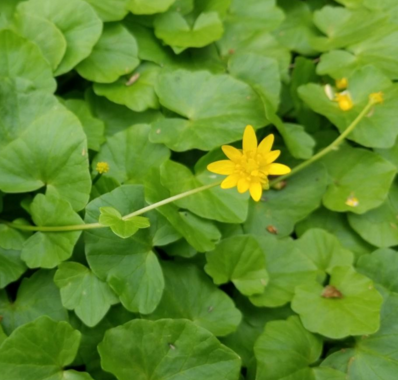Identifying native or invasive plants can be challenging. Mitigating the damage that can come from the spread of an invasive species is a tough battle. Invasive species often spread and grow due to human behavior, like walking or moving firewood long distances. It can happen unintentionally when you're outdoors or traveling from one place to another.
One of the many reasons the Nature Center employs a full-time Natural Resources Specialist (NRS) is to monitor and manage our conserved land. Our NRS closely examines each habitat, scanning for potential issues that could threaten plants and wildlife.
This spring, a seemingly innocent yellow flower that adds a splash of color to the sea of green in our Marsh raised a red flag. Upon first glance, it appears there is only one species of flower growing, when in actuality there are two which happen to look very similar. Closer examination revealed that one is a prized native, while the other is an aggressive invader.
WHICH ONE IS WHICH?
Both have yellow flowers on low growing plants with buttercup leaves; but on closer examination, these plants are quite different. Take a look at the two and study the petals, leaves and coloring. Can you note the differences?


MARSH MARIGOLD VS. LESSER CELANDINE
Marsh marigold (on the right) is a native wildflower, with big golden buttercup petals which blooms in early spring in open, wet areas. It is taller and more robust than Lesser celandine and never grows in an invasive manner. Stems and leaves are larger and hardier and typically darker green than Lesser celandine and the plants remain above ground through the growing season.
Lesser celandine (on the left) is a non-native, invasive plant that swallows up acres of ground throughout Northeast Ohio. Lesser celandine spreads primarily via small underground tubers or above ground bulbils. It emerges in late winter or very early spring, becoming a carpet-like ground cover in heavily invaded areas.
THE PROBLEM WITH INVASIVES?
Like many invasive species, Lesser celandine crowds out native wildflowers and can eliminate other plants in its path. This creates a threat to the biodiversity of an ecosystem. Some invasive species can alter the amount of native, diverse species that provide shelter and food sources for native wildlife.
This plant in particular is toxic and can be a problem for livestock. After a brief active period of 1-2 months, the plants shrivel in late spring not returning until the following year. Controlling extensive outbreaks requires herbicides (such as Glyphosate products) as it is nearly impossible to remove all tubers and bulbils from the soil manually.
WHAT TO DO ABOUT INVASIVE SPECIES ON YOUR LAND?
The first step is a preventative one. If you're still planting or planning for next year, verify that the plants you are buying are not invasive. Don't be afraid to ask for help in identifying which is which. Clean your shoes and boots, as well as any equipment you may use outdoors to remove insects and plant parts that may aid in the spread of invasive species. Don't dig up wild plants to relocate them in your yard without first researching if it's native. If you find an invader, like Lesser celandine, on your property fast action is advised. Allowing the plant to spread could be quite costly to remedy at a later date.
Learn more about common invasive plants in Ohio and join us for an upcoming Stewardship Saturday, where you can learn from our NRS and help lend a hand in managing our land.
